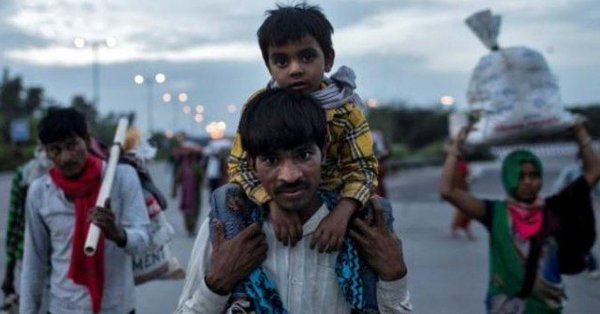This was stated in a study , titled “How Are Indian Households Coping Under the Covid-19 Lockdown? 8 Key Findings”, carried out by experts at the University of Pennsylvania, the University of Chicago and the Mumbai-based Centre for Monitoring the Indian Economy (CMIE).
“Direct and immediate transfers of food and cash are very high priority,” said Heather Schofield, assistant professor of medical ethics and health policy at the Perelman School of Medicine and a Wharton professor of business economics and public policy.
India’s mass exodus from cities triggers village property disputes
When a nationwide lockdown began in late March, India’s Ministry of Labour and Employment asked private and public organisations not to terminate jobs on the pretext of prevailing conditions. But these pleas hardly made any difference and large-scale retrenchments have taken place as businesses have been hit hard due to the ongoing crisis.
However, the study found a “sharp and broad negative impact on household income” as the pandemic diminished their staying capacity, adding that the unemployment rate in the country had crossed 27% in early May, up nearly four-fold from levels in January-February.
Lower, middle segment most severely affected
The fall in incomes affected people in the lower and middle segments of the income distribution most severely, the study found. “Households in the lowest of the five income groups had average monthly per-capital earnings of less than Rs3,800 (about $50), while those at the high end made between Rs. 12,374 and upwards of Rs1 lakh ($167 to $1,370 and more).”
Households in the middle-income groups are hurt disproportionately more perhaps because they are most likely to be dependent on sources of income that are hit due to the lockdown, the study’s authors stated.
“The households in the highest quintile are more likely to have stable salaried jobs, with the ability to work from home and continue to earn a living,” they added.
“Households in the lowest quintile may be more heavily concentrated in occupations that have continued despite the lockdown (e.g., agriculture, food vendors) or have benefited from targetted transfer programmes.”Mask-wearing worshippers in temples as India reopens amid rise in coronavirus cases
Rural households have seen disproportionately more distress than those in urban India during the lockdowns. Incomes have fallen at some 88% of rural households, compared to 75% at urban households, the study found.
Higher-income households in urban India have shown more “resilience” than their rural counterparts. That is because working out of home is possible for many urban jobs, and therefore they are “relatively protected,” the authors noted.
Precarious economic situation
The economic situation is precarious. “Given the low baseline wealth of many households, a very large share of Indian households state that they will be unable to continue — even over relatively short periods — without additional assistance,” according to the paper. Across India, 34% of households will not be able to survive for more than one week without additional assistance, the survey found.
Only 30% of households are able to survive one month or more without additional assistance. “Crucially, 14% of the sample is already out of funds and risks immediate and severe deprivation if they are unable to borrow or receive additional benefits,” the report warned.
“Rapid distribution of in-kind or cash transfers is needed to prevent a sharp increase in malnutrition and severe deprivation. Such transfers will also likely promote a more robust recovery as the country is able to reopen.”
The need for additional resources is also affected by where the household is located. “The urban poor have the least time before their resources are depleted,” the study said. Nearly two-thirds of urban households that earn less than median income households will run out of resources in two weeks. Rural households in similar income groups have relatively more resilience, the study found, as 54% of them have sufficient resources for the same period of time.
The five states with households in most urgent need for funds — based upon two-week survival — are Jharkhand, Bihar, Odisha, Tamil Nadu, and Kerala. Himachal Pradesh, Uttarakhand, Meghalaya, Haryana, and Telangana are among the most resilient over a two-week period. “The need for resources — such as sustained and broad base of transfers — is urgent as nearly all households will be unable to survive without transfers in the medium-run,” the study said.
‘Significant number of salaried workers lost jobs’
CMIE in another report said, those who lost jobs also included a significant number of salaried workers apart from small traders and wage labourers.
The report said small traders may return to work after the lockdown, but it will be difficult for salaried workers to find a job in the near future.
India sees fatal 24 hours due to coronavirus
Millions of young workers in their 20s have lost jobs because of the lockdown imposed beginning March 25, said the report.
“Over 27 million youngsters in their 20s lost their jobs in April. This has serious long-term repercussions. It is during this age that young India builds its career in the hope of a bright future,” said CMIE CEO Mahesh Vyas.
Prime Minister Narendra Modi announced a 21-day nationwide lockdown on March 24, giving the nation less than four hours notice before it took effect.
The Indian government has announced three rounds of stimulus programmes totalling nearly Rs21 trillion ($266 billion). That includes a Rs7.2 trillion liquidity package the Reserve Bank of India had unveiled in February before the coronavirus, which it followed up with other measures to stem the pandemic-induced economic slowdown.
However, the stimulus programmes have largely been either credit guarantee programs or new fund creations to be shouldered by banks and financial institutions, Reuters reported.
































